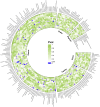Association between gut microbiota and pan-dermatological diseases: a bidirectional Mendelian randomization research
- PMID: 38562964
- PMCID: PMC10982508
- DOI: 10.3389/fcimb.2024.1327083
Association between gut microbiota and pan-dermatological diseases: a bidirectional Mendelian randomization research
Abstract
Background: Gut microbiota has been associated with dermatological problems in earlier observational studies. However, it is unclear whether gut microbiota has a causal function in dermatological diseases.
Methods: Thirteen dermatological diseases were the subject of bidirectional Mendelian randomization (MR) research aimed at identifying potential causal links between gut microbiota and these diseases. Summary statistics for the Genome-Wide Association Study (GWAS) of gut microbiota and dermatological diseases were obtained from public datasets. With the goal of evaluating the causal estimates, five acknowledged MR approaches were utilized along with multiple testing corrections, with inverse variance weighted (IVW) regression serving as the main methodology. Regarding the taxa that were causally linked with dermatological diseases in the forward MR analysis, reverse MR was performed. A series of sensitivity analyses were conducted to test the robustness of the causal estimates.
Results: The combined results of the five MR methods and sensitivity analysis showed 94 suggestive and five significant causal relationships. In particular, the genus Eubacterium_fissicatena_group increased the risk of developing psoriasis vulgaris (odds ratio [OR] = 1.32, pFDR = 4.36 × 10-3), family Bacteroidaceae (OR = 2.25, pFDR = 4.39 × 10-3), genus Allisonella (OR = 1.42, pFDR = 1.29 × 10-2), and genus Bacteroides (OR = 2.25, pFDR = 1.29 × 10-2) increased the risk of developing acne; and the genus Intestinibacter increased the risk of urticaria (OR = 1.30, pFDR = 9.13 × 10-3). A reverse MR study revealed insufficient evidence for a significant causal relationship. In addition, there was no discernible horizontal pleiotropy or heterogeneity.
Conclusion: This study provides novel insights into the causality of gut microbiota in dermatological diseases and therapeutic or preventive paradigms for cutaneous conditions.
Keywords: dermatological diseases; gut microbiota; inference; mendelian randomization analysis; therapeutics.
Copyright © 2024 Wang, Yao, Lin, Ge, Huang, Gao and Wu.
Conflict of interest statement
The authors declare that the research was conducted in the absence of any commercial or financial relationships that could be construed as a potential conflict of interest.
Figures





Similar articles
-
Investigating causal relationships between the gut microbiota and inflammatory skin diseases: A Mendelian randomization study.Australas J Dermatol. 2024 Jun;65(4):319-327. doi: 10.1111/ajd.14231. Epub 2024 Feb 28. Australas J Dermatol. 2024. PMID: 38419189
-
The causal relationship between gut microbiota and inflammatory dermatoses: a Mendelian randomization study.Front Immunol. 2023 Sep 27;14:1231848. doi: 10.3389/fimmu.2023.1231848. eCollection 2023. Front Immunol. 2023. PMID: 37828993 Free PMC article.
-
Causal relationship between gut microbiota and tuberculosis: a bidirectional two-sample Mendelian randomization analysis.Respir Res. 2024 Jan 4;25(1):16. doi: 10.1186/s12931-023-02652-7. Respir Res. 2024. PMID: 38178098 Free PMC article.
-
Genetic liability of gut microbiota for idiopathic pulmonary fibrosis and lung function: a two-sample Mendelian randomization study.Front Cell Infect Microbiol. 2024 May 22;14:1348685. doi: 10.3389/fcimb.2024.1348685. eCollection 2024. Front Cell Infect Microbiol. 2024. PMID: 38841114 Free PMC article.
-
Exploring the potential causal relationship between gut microbiota and heart failure: A two-sample mendelian randomization study combined with the geo database.Curr Probl Cardiol. 2024 Feb;49(2):102235. doi: 10.1016/j.cpcardiol.2023.102235. Epub 2023 Nov 30. Curr Probl Cardiol. 2024. PMID: 38040216 Review.
Cited by
-
No Associations Between Genetically Predicted Chronotype, Insomnia, Daytime Sleepiness, or Physical Activity and Acne Vulgaris: A Two-Sample Mendelian Randomization Study.Clin Cosmet Investig Dermatol. 2025 Apr 6;18:827-835. doi: 10.2147/CCID.S510739. eCollection 2025. Clin Cosmet Investig Dermatol. 2025. PMID: 40225312 Free PMC article.
-
The causal relationship between the gut microbiota and urticaria: a two-sample mendelian randomization study.Arch Dermatol Res. 2024 Dec 7;317(1):79. doi: 10.1007/s00403-024-03589-7. Arch Dermatol Res. 2024. PMID: 39644329 No abstract available.
References
MeSH terms
LinkOut - more resources
Full Text Sources
Medical

